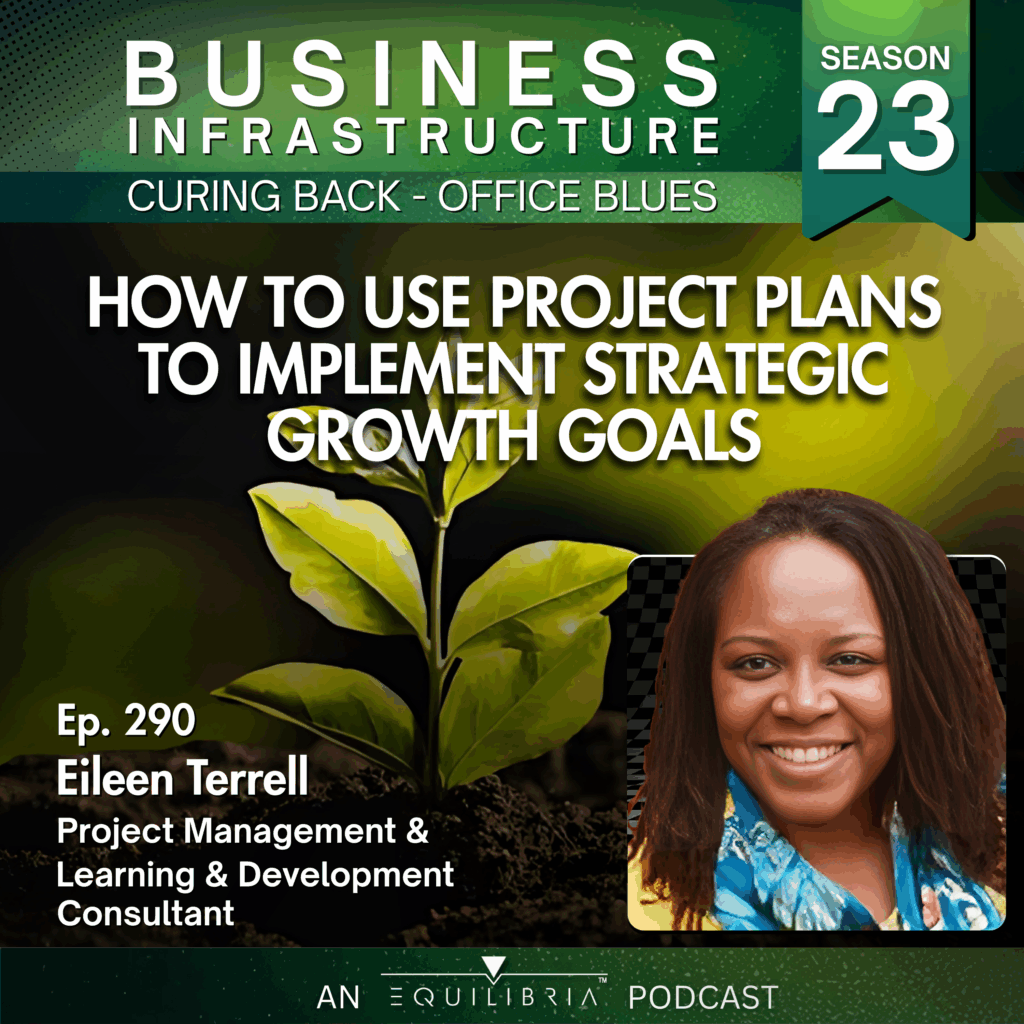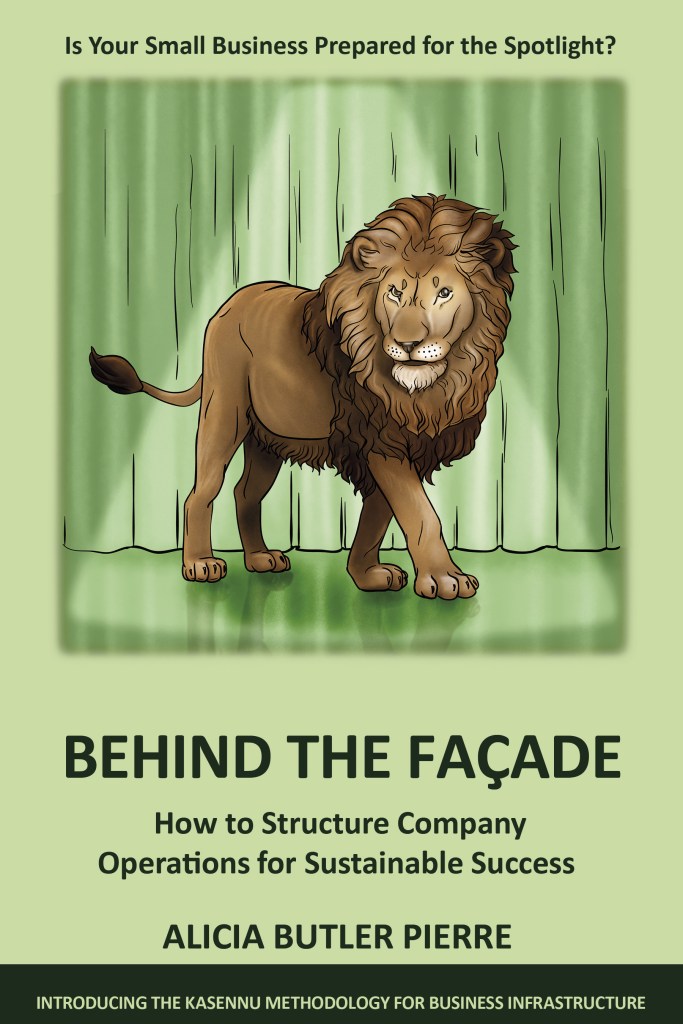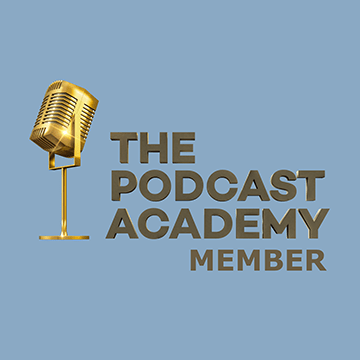Transcript
We’re back with Season 23 of the Business Infrastructure Podcast – the show where we share operational tips, tactics, and strategies to help you cure any back-office blues you might be experiencing.

As a reminder this season features a masterclass in growth strategies. At this point, we’ve talked about the importance of ideation, vetting those ideas, and then creating a strategic growth plan around those vetted ideas. But how do you actually implement that strategy? That’s what we’re going to focus on next. That’s what we’re going to focus on next.
This is Ep. 290: Eileen Terrell Explains How to Use Project Plans to Implement Strategic Growth Goals
This episode is particularly special to me because it involves someone who has listened to this show from the very beginning, all the way back in 2018! It turns out we have a mutual colleague and friend, and, through a chance conversation with that friend he connected me with Eileen. And now, here we are.
Eileen Terrell is our featured guest and she’s an expert not only in project management but also in the professional learning and development space as well. Though her career always involved learning, Eileen wasn’t always a project manager.
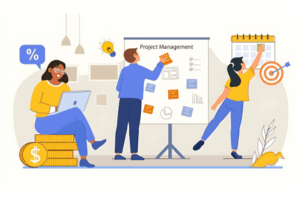
I had the joy and just the experience to work with what I would call visionary leadership twenty years ago, I started in the learning world for a professional services HR firm and my role was really to design and develop learning experiences. This particular leader said, “Yes, you can design and develop learning, but guess what, we build clients. You also need to manage your deliverables. We need to be aware of our costs. We need to make sure we’re not missing deadlines. We need to make sure that we’re understanding how we’re working with our stakeholders beyond learning.”
And so this visionary gave us an option. It was not required to all the learning team. Let’s go through the process of obtaining our PMP.
Twenty years ago, that was the only designation there was. There wasn’t a CAPM. As far as the other designations and the PMP, the Project Management Professional designation, the certification was challenging but it really gave me a look at how do I not only design and develop great learning, but how do I manage the learning to ensure that I’m coming in under budget, I’m managing the risk, I’m reducing rework and I’m meeting deadlines.
That was the biggest gift that this leader gave the team in that entire time. And what was so interesting is that we didn’t understand at the time the value of having a formalized approach to project management until we went through the process. It is a very challenging process to go through the study and then to take the test. And I have maintained that and continue to learn more about project management and ways of managing different cultures and industries and things like that. I have to give kudos to my leadership 20 years ago that says, “Yes, you’re a learning professional, but guess what, you also need to manage and be a really great steward of our time and resources for your learning projects.”
Before we get into the details of how you can leverage project management to implement your growth strategy, let’s learn a little more about Eileen’s background. She mentioned that her official project management certification happened 20 years ago, but what type of work was she doing? What was her educational background? How did she land in the type of work she does currently?
I’ve always had an interest in HR. One particular organization that I was looking to get into did HR benefits consulting. Without the formal learning experience, because 20 years ago you had to have a master’s in learning in order to go into learning. My initial goal was how do I just get into the HR firm? I have an interest in HR, I understand benefits and then, figure out a way to navigate to learning.
So I actually started under the HR umbrella doing the administration. I was a system tester for HR feeds that went from the benefits administrator to the different clients. And through that world, I understood HR benefits inside and out and plans and details like that. And then concurrently I went back to school for my master’s because ultimately my goal was to get into a learning function. And so I did that. I obtained my appropriate education, and I stayed with that company, but moved into a learning professional capacity.
In case you’re wondering, what Eileen means regarding “learning professional capacity” is her work in equipping employees with the skills and knowledge necessary for their personal and organizational growth. This ultimately led to her working independently as a consultant specifically focusing on learning and development for a number of different clients of different sizes across different industries. And, as you probably guessed, her work is usually organized as projects. In fact, her work as a project manager began with that same boss who suggested she and her teammates become certified Project Management Professionals or PMPs
When I worked for the HR benefits consulting firm, it was an HR forum. When we did learning, they wanted to ensure because we were billable for clients firm so everything we did had money tied to it. Our clients were external, they were not internal. So it was actually in that capacity that I started to understand project management because the entire team sat for the Project Management Professional certification. Through my entire careers in learning, project management have never been separate for me. There were times when I was sourced to only do project manager.
Now this brings us to where we are in our Growth Strategies masterclass. You have a vetted and validated idea, you’ve included this idea into your long-term growth strategy. The X-matrix you completed contains a snapshot of some key projects that, once implemented, will move your company towards those growth targets.
Now comes the hard part – structuring those projects for implementation. If you’ll recall, the X-matrix includes a section where you identify the people who are ultimately responsible for each project’s success. In a smaller company that could be you as the founder or CEO or it could be an independent project management consultant like Eileen. But you may not know what qualities or attributes to look for in a project manager.
Knowing what is required to become a PMP can give you a good understanding of what to expect from a knowledge and experience perspective if you are looking for someone to manage your projects.

First is the preparation process. The preparation process for me was multifaceted. I leveraged study groups. The good thing about going through it with a group of people I work with is that we leverage our lunch break literally just to review the concepts, have conversations about some of the things that we didn’t have.
We also attended a formal prep class. The formal prep class, I’m not sure if it was six or eight hours, but that person is an experienced education provider that knows project management, the PMP, very well to help us talk through some of the concepts. As project management, as a formal area of expertise, was new to me I didn’t know the terminology. I didn’t really understand the process. Project management also has a lot of formulas now. The good thing now is that there’s so many software packages that you don’t have to do the manual formulas anymore, but just understand that.
So a little bit of math, which I was like, Oh, my goodness, math is not my best friend. But also just concepts. And then individually, I went old school. I came up in a time where we used flashcards and I did the standard index cards where I would write out some of the terms that were some of the formulas, it was a little bit more challenging for me. There was also digital flashcards. So anytime if I’m at the doctor’s office, if I’m at Starbucks, I’m going through my flashcards before you can even be allowed to sit for the exam, back then, you had to have so many years experience, you also had to demonstrate the application of, back then, the different areas of project management as well. That had to be submitted as part of your application before you’re even eligible to sit for the exam.
You may be wondering if all great project managers are also certified PMPs. The answer is, “No.” And someone being a PMP is also not a guarantee that their certification is active, nor does it mean that person will have great people skills as Eileen will share later. But I wanted to hear Eileen’s thoughts on this. Should projects be led by certified PMPs?
There’s a part of me as a certified project manager that says, Yes, they should, because they’re going to understand that it’s not just sitting down, creating a project schedule. However, if someone has worked with a certified project manager, we learn through experiences. Nowadays we have YouTube, we have LinkedIn learning. You have all of these resources to help us build up that area of knowledge and our experiences. So I wouldn’t want to exclude anyone that understands the methodology as well as the discipline of project management.
Sometimes if you get a certified project manager that has not worked with a variety of industries or people, they could be considered too stringent and not flexible enough to really adapt to that culture and that project. You do need someone that is an experienced project manager that understands that project management is about the relationships and the tasks. Relationships first, and that they’re working as part of a group. Because as a great project manager, that person is never creating a project schedule alone. The first thing they taught us is that when you go to create your project schedule is that that’s as a team.
Because I can’t tell you how long something takes. I may not know how long it takes to design a system code. So creating that project schedule is a dialogue between the people that actually are getting the work done. Being able to create those authentic relationships and business relationships are important.
And part of that team formation involves gathering different Subject Matter Experts or SMEs. Does a PMP or project manager also have to function as a SME on a project? I’ll use my company as an example. Does a project manager have to understand learning and development in order to oversee our project to stand up a new training division?
My answer is no. Because they don’t have to be a SME in what they’re managing. They have to be a SME in the discipline. And I say that because as an independent consultant, I know learning and project management inside and out. When I go in as a consultant, I don’t know your business. If I’m going in to work for ABC Organization, I may have no idea how to design perfume, but I know the methodology to use and I know how to build those relationships. In order to understand how do we start and how do we get to the end state.
Okay, so now that we know how to search for the right type of help to lead and manage our strategic growth projects, what happens next? From experience, we probably know that we shouldn’t just dive right into doing the work. That work must be organized and structured based on things like task breakdowns, assigned responsibilities and target completion dates. Should that be done in a project plan or a project schedule? Are they the same thing? If not, what are the differences?
They are not the same thing. The project plan is an umbrella in which a project schedule exists. A project schedule is actually the list of tasks and the dates that are used to manage the task. The project plan could include what’s my communication plan, what’s my risk management plan? It’s all the things that make up project management. The project schedule is actually only one piece of a project plan. For me, I can usually tell pretty quickly if someone has a formal PMP or PMI background because they’re using project plan as a thing that actually has the list of tasks, who’s completing them, the start time and the end time. The formal name for what that actually is the project schedule.
Think of a project plan as a store, like Walmart. So Walmart is my project plan, but if I’m only going to buy paper towels, that’s my project schedule. A project plan is dynamic because you’re building the different pieces at different times. So first thing I’m looking at, to make sure I’m understanding, what is the plan, what’s the scope? Your project schedule is not coming first. It’s probably more of your scoping document that has to come first, and the project schedule becomes an output of that. Your project plan is just the umbrella for all of the other things in which project managers use to get it to the end state.
Okay, now that we know the difference between a project plan and a project schedule we can probably start to incorporate some elements of business infrastructure into building both. If you’re new to the show, business infrastructure consists of three elements – people, processes, and tools and how these elements are interconnected to build a foundation for sustainable growth and profitability. Let’s cover the people element first. Who do we need to consider? Turns out there’s levels to this element.

First and foremost, who’s the sponsor? Who is requesting the project? Who is paying for the project? Who has the power to stop the project? So, start with the sponsor to really understand what business need or why is this project in existence. Next, talk to the key stakeholders, maybe not the worker bees just yet or the people that actually doing the work, but start to think through what are the different areas that are impacted.
When I say stakeholders, if someone is rolling out a new software, you have the people that are designing the software, but then also the people that their workflow or their work task will be impacted by this. If I think about input in, output out. Who’s gonna be impacted with it? Who’s initiating this? And then also not forgetting people like our change management people, right? So if you’re putting something into place that’s gonna impact the entire organization, then let me pull in my change management people so that we even understand what’s going to be the people impact of the system implementation, potentially even your communications people. You want to just understand how do we move this smoothly across the entire organization?
My next level – I’m going to go to my SMEs. The people that actually do the work, they’re going to tell me what can go wrong. They’re also going to tell me what is going to be the work effort to get this done. In fact, I think about my project team, my SMEs and some key stakeholders would be the people that I would be meeting with on a regular basis.
Before we move on to the other elements of business infrastructure, it’s worth noting the role of the project manager. You may have had some experiences with project managers that were completely hands off, relying solely on the SMEs and key stakeholders to do all the work. Conversely, you may have had experiences where project managers might be overly involved, acting as micro-managers. Neither approach is helpful, and can be harmful if it goes unchecked.
That is a great segue to the evolution of the Project Management Institute. I say that because the old world…one of the documents that we’ve used to prepare for the exam as well as reference is called a Guide to the Project Management Body of Knowledge, also known as a PMBOK. Prior to the seventh edition that they’re currently on, is we focused on the knowledge areas.
People really wasn’t called out that way. But the evolution has seen, it’s not just about the process, project management includes project management principles. And it’s interesting, one of the principles of project management is leadership. Other principles include systems thinking and stewardship and team and stakeholders, adaptability and resiliency. And so when you think about that people side of project management, they have evolved to say, let’s call out some of those people skills.
Leadership is very important. There’s the project leadership as far as how do I make sure this gets over the finish line. But there’s also project leadership as to how do I build relationships, how do I ensure that I’m communicating on a regular basis? When you’re not a SME, it’s even more so to rely on your people. So when I go in, I am building relationships, I am talking to lots of different people and not only just kind of talking at them, but talking with them, looking to understand. And I’m not just sending a status report via email and saying, Oh okay, they got it. No building those relationships, really understanding their business is key. We got to bring in some of this people stuff and not just kind of focus on the process stuff. So, leadership is one of the principles of great project management.
Communication isn’t called out as one, but there is common under systems thinking. So when you think about, you got this organized chaos – the right hand doesn’t know what the left hand is doing. From a systems thinking perspective, I’m constantly trying to make the connections A to B, C to D, how does A go to E, how does A go to Z? Right? So that systems thinking, the communication falls under that. And from a team perspective. In order to manage a team, and to lead a team, communication has to be there. You need to be able to create a collaborative team environment. You need to be able to demonstrate those behaviors. Those are the subsets. And in order to do that you have to communicate effectively.
This is a nice segue to another element of business infrastructure – tools. I asked Eileen about the role that technological tools play in not only communicating effectively, but in also scheduling the project work.
ClickUp is the one that I am testing right now and more so because ClickUp is very dynamic and it offers so many options. Now here’s one thing I will say though is the first thing I do when I go into a project is understand what type of software firewalls are in place first and foremost. So I’m not going to even say that you shouldn’t use Excel. What I’m saying is there is some cloudbased tools such as ClickUp, such as Monday.com if you’re in an environment that is cloud-based, especially if you’re managing a global team.
One of the first ones coming out the gate early back was Smartsheet. Others have come beyond Smartsheet, but Smartsheet is actually the one that I started probably 15 years ago. And since then, it continues to also amaze me. So I would say Smartsheet from ease of use, ClickUp depending on how complex the project is and depending on the firewalls and what’s actually within the environment in which you’re managing.
Google, used appropriately, and maybe finding a shared site to share too whether you’re using Dropbox or things like that, you work within that particular thing. But that cloud-based tool, not only is it good for accessibility, but it also gives transparency and visibility so that everyone knows what’s happening at all times.
Eileen mentioned Smartsheet, Monday.com, and ClickUp as cloud-based tools to schedule and manage your project. Another great feature of these types of tools is the transparency that they offer to the other team members you invite to view the project information. There’s also other tools like JIRA.
IT projects are typically used in JIRA and I think because they’re tracking incidents and things like that. It’s interesting. Years ago, MS Project was one that was used exclusively, and I think as the cloud-based ones have come out the gate like Smartsheet and ClickUp and Monday, that it is not as used because MS Project does not come part of the standard Microsoft Suite, it’s an add on.
And so a lot of organizations, at least organizations I have experience with instead of saying okay, does it make sense to pay the subscription to MS Project or does it make sense to pay the subscription to Smartsheet? One of the things that Smartsheet, Monday and ClickUp have done a phenomenal job is that reporting piece and just make it seem not so scary to use.
I probably have not touched MS Project easily in over five years because I’ve been in the Smart Channel sheet and ClickUp because their interface is people friendly from a perspective you don’t have project management. So, if I wanted to give my clients a status report, I can have two or three different ways in which to show that. I have the visual tracking as well as here’s your task, here’s the capability to put on someone else’s calendars. The interface has made it more accessible for people to use it.
At this point, Eileen has covered the people and tools elements of business infrastructure. What about the third one – processes? Considering the wide variation and sizes of projects, how does the project management process typically work?
The old way of initiating phase and planning phase and executing and things like that is where project management was for many, many, many years. And just like everything else in the world, there’s this dynamic everything is not sequential per se. There is a process. The old way of initiating, planning kind of gave the illusion that there’s a start and a stop. There’s gates. Right, okay, we’re done with initiating, so now let’s move to planning.
The new way says, we need to kind of go to these project performance domains. There’s still a process, but before you can kind of get to the formal development approach and lifecycle is, Who are the stakeholders? Who are the people that need to be involved and at what level do they need to be involved one of the things that I start with?
RACI is an acronym for Responsible, Accountable, Consulted, and Informed. It’s a project management tool that nicely summarizes all the people involved in a project, including those SMEs and stakeholders Eileen mentioned earlier. In the RACI chart, you check off the level of involvement required for each person listed. This is the tool that Eileen says she uses to begin any of her project management processes.
I create that chart. So I’m thinking about my stakeholders, I’m thinking about who’s responsible for what, who’s held accountable, who should I be consulted with and who should be informed? If you are external, coming into internal, your ability to ask the questions and who else and who else and who else?
Because you may not know all the players and so if someone’s hired you, they may say, here’s your team, here’s the people who you need to talk to. But using your systems thinking, using that project leadership and those communication skills, you’re going to need to continue to ask the questions. And I sometimes will use that RACI framework to ask questions if I’m external, coming in. If I’m internal, it’s a little easier to kind of navigate the people side. Second, I’m thinking about who’s my team? Who are the people that need to get the work done? If I’m project manager, what other roles do I need to have on this team?
Do I need to have a communications person? A person that’s going to actually be giving the system updates? Do I need to have my project sponsor from the perspective of how do they help me navigate the organization? How can they help me influence key decisions? If I happen to run into something that I need to overcome, whether it’s a cost or whether it’s a people issue, who’s that person that’s going to help, for lack of better term, block and tackle?
That person that can say, I can remove the obstacles getting in the way of getting the project done. So starting with the people side is the first part of the process.
So far in the project management process, Eileen suggests starting with the RACI, and then understanding any additional team members required outside of the core team. What’s next?
Once you’ve done that, you then are going to assemble and say, what is our approach? There’s so many different methodologies with project management. I’ve heard Scrum, I’ve heard Agile. I’m not an expert in those areas, but project management has evolved because your approach to how you’re going to do it is going to be based on the type of project you have.
That’s Step number 3 – determining the project approach or framework you’ll use. Lean Six Sigma, for example, is one of those approaches you might consider using. Or, you may also find that the optimal framework is a hybrid or combination of one or more approaches. Now, for the next steps

Then I’m going to sit down and say, what is the schedule, what is the timeline? What are the risks? Because now I have assembled all the right people, I am going to create my risk management plan.
Whether you create the risk management plan first or whether you create the project schedule first, they become hand in hand. If you do one in the morning, may do one in the afternoon, by having the right team, you’re going to be able to first identify what are all the tasks, what are the key milestones, what’s the duration, what are the dependencies in order for me to get to this particular thing? So as a team, we’re going to build out that project schedule.
As a team, we’re going to identify all the risks. Even if I know how to design software, I may not know the servers in which this software must be loaded. By having my person on my team that manages our service, that manages the cloud, if it’s going to be cloud based, they can identify the risk of what can go wrong and how do we go ahead and identify our risk mitigation strategy. A project manager should never be doing any of those in silo because they’ll never be a SME in all the areas in which they need to be a SME in.
Once you have your project schedule and risk management plan in place, now it’s for time for a sanity check.
You’re kind of moving to what I’m calling the planning phase, where there’s some conversations happening of where can we combine the tasks, where can we say we do this now, we do this later, where do we need to reprioritize?
The work is beginning. The other part of this planning and we think infrastructure and it’s kind of baked into the whole team and your risk and your communication is also establishing a ways of working. Ways of working is not a project management term. Let me make sure I call that out. We want to define from a communications perspective, how are we going to stay connected? Are we going to have daily 15 minute check ins?
These 15-minute daily check-ins come from the Scrum framework for project management and are a great example of combining one project management framework with another to best complete your project. Pay careful attention as Eileen describes the different types of meetings that take place during your project which, by the way, ties into your communications plan.
What are the standing meetings? What are the project meetings? What are the agendas for these meetings? Who need to be included? You use the word infrastructure, what’s going to keep us connected as a team so that everyone knows what they should be doing, everyone is aware of where we are, what are the statuses as well as the technology, what tools will we use?
If we said we’re going to use Smartsheet, does everyone know how to use Smartsheet? Does everyone have access to that? What are the expectations as to who’s putting in their updates and when and how that communication continues to go up to the sponsor so that they’re aware of what’s happening. So we’re in work mode, we’re planning, we’re in that project work and then we’re meeting as expected.
So whether we’re having our weekly project meetings or daily check in meetings and we are doing a check and adjust based on key milestones and one of the things that’s constantly being updated and managed is that project schedule, is that risk planning. Are we managing our risk to some other risk surface that shouldn’t be there and how are we mitigating that? Are we communicating to the right people what those risks are so there should be no surprises of why something happened if a deadline is missed.
If we go back to our risk plan, in theory there should be a relationship between why something was missed and if you missed a deadline. Now things happen, people get sick, you know, things happen like that. But those documents become your living documents. And you continue to manage the work as the work gets completed. We have this formal We completed the project and that’s what I really love about that people side is that we’re also making sure we’re celebrating, we’re acknowledging, so we get to the end and not forgetting to make sure that we evaluate how we did. We’re doing that formal kind of project closeout and we’re creating
documentation. So that’s a very high-level way of managing a project.
To recap, the general project management process that Eileen shared involves creating a RACI, identifying other key team members, and identifying the technologies and other tools to communicate about the project. Next, she shared the importance of creating the actual project schedule along with a risk management plan. Then creating a communications plan that includes the types of meetings that will take place and at what frequency.
As the work for the project is underway, then you continue to monitor and report on the progress. Make sure you document everything along the way because hiccups can and will likely happen. Once the project is completed, make sure you celebrate with your team!
Considering Eileen’s deep expertise, I asked if she could share any additional project management resources with you.
First and foremost, I always recommend the PMBOK Guide through the Project Management Institute. It’s a reference book you don’t need to read it to cover to cover. Make sure that you have the most recent PMBOK guide because they do update them.
The Project Management Institute website has so many resources. They have developed certifications based on maybe people that are new to the field, which I love about accessibility. How do we make this accessible to anyone that’s interested in expanding their approach and their knowledge of project management and from a podcast perspective, Project Management Happy Hour.
I recommend this for a couple of different reasons. Similar to your podcast, it’s conversational. It’s two people that in some cases they’re getting very formal, talking about risk analysis and other things. They’re talking about that people side like what happens when your project goes sideways, how do you get it back on course? They talk about all the different types of, what’s agile versus waterfall.
When you’re having a status meeting, how do you manage that person that’s disruptive in a project meeting? And so those would be my three go-tos is the PMI Project Management Institute website, they have tools, they have templates, articles, webinars, anything you can think you want to know from a formal perspective. The PMBOK guide is my reference and I often bring it out. It’s not about memorizing what’s in the book, but it’s really understanding what types of things could fall into this category.
And it gives me questions to ask, especially going in as a non-SME, it’s very important that I’m asking those questions. And then the PM Happy Hour podcast, it’s like having a conversation about all the different things that could happen on the project.
And I’ll just bring up one more thing really quickly. I know earlier in this interview you mentioned LinkedIn Learning. Is there a particular LinkedIn Learning course you’ve come across that you can recommend?
So my short answer is no. There are a lot of project management courses on LinkedIn Learning, but because PMI Institute and I’m a certified project manager, I tend to go there first.
That’s good to know! And speaking of things that are good to know, in case you’re still not sold on project management and how it can serve as the mechanism for implementing strategy, Eileen has some parting advice to share with you.
Part of the thing is work as a team, meaning ensure that the people that have to actually do the work is part of the conversation, because the people that are doing the work can tell you everything that can go wrong with it, they are key to it. If someone’s creating a PowerPoint presentation, people that don’t do it on a regular basis, like, Oh, well, you just go create the PowerPoint. But there is a thought process that goes into how do I structure? Like, what’s the key point of this?
The formal approach to project management ensures I identify all of the tasks that need to get done with the input of the people that have to do it. And they’re giving me the reality of how long it takes. But they can also tell you, where can I potentially shorten it and still meet the minimal viable product of the requirements? And where it’s like, well, no, we can’t shortchange this because now we’re dealing with external agencies and we can’t speed up their process. So in order to do that, let’s go ahead and start earlier.
And time is money, right? At the end of the day, using great project management methodology will save you money because you’re reducing waste, you’re reducing not knowing the risk. If you’re trying to beat your competitive market, then the best way to do that is to be as efficient and effective as possible. In not identifying what it takes to get the work done with the people who do the work, that’s the biggest risk you take.
Well, on that note, Eileen, thank you so much for coming onto the show. You are a wealth of information and I’m just so glad that we have the opportunity to make this happen.
Thank you, Alicia
And thank you for listening! If you’d like to connect with Eileen, then go to BusinessInfrastructure.TV. There you’ll find links to the project planning resources she shared. Again, you can find this information in the show notes at BusinessInfrastructure.TV.
If you enjoyed this episode, then please subscribe, give us a five-star rating and leave us a review.
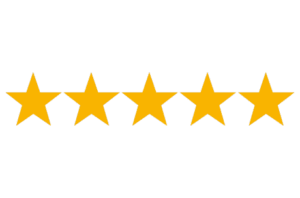
Join me in the next episode where I’ll share how we here at Equilibria built project plans based on the information in our X-matrix. Be sure to come back to the place wherever you’re listening so you don’t miss this next episode! Until then, remember to stay focused and be encouraged. This entrepreneurial journey is a marathon and not a sprint.
This podcast episode was written and produced by me, Alicia Butler Pierre. Audio editing by Olanrewaju Adeyemo. Original score and sound design by Sabor! Music Enterprises. Video editing by Gladiola Films. A special thank you to our sponsor, Equilibria, Inc., and to Hashim Tale for creating the show notes.
This is the Business Infrastructure – Curing Back-Office Blues podcast.


